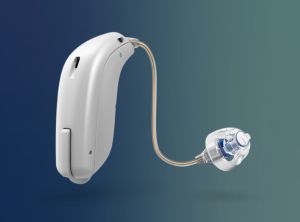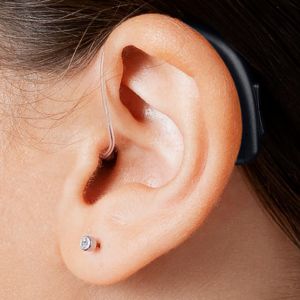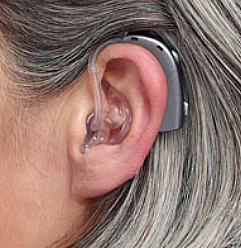[ad_1]
Contributed by Debbie Clason, staff writer, Healthy Hearing
Last updated
Today’s hearing aids are a lot like mini-computers for your ears. And although you don’t necessarily need to understand how the technology works, it’s always a good idea to have a basic understanding of the various parts so you can troubleshoot if a problem should arise.

In that spirit, the following components are parts of a modern receiver-in-the-ear (RITE) hearing aid, also known as receiver-in-ear (RIE) or receiver-in-canal (RIC). It’s the most common type of hearing aid sold today. (Custom, fully in-the-ear hearing aids work similarly, yet with all the parts contained in just one small piece worn in the ear.)
If you’re not sure what kind of hearing aid you have, see more on typical types and styles of hearing aids.
Internal parts of a hearing aid
The largest part of your device is the body of the hearing aid, which sits behind your ear. The hard plastic casing houses the battery and three important components:
- Microphone The microphone picks up sound and sends it to the amplifier. With today’s technology, some hearing aid microphone processors are so sophisticated, they can distinguish between speech and background noise, making it easier for the user to understand conversation in noisy environments.
- Amplifier The amplifier converts sound into an electrical signal and sends it to a receiver/speaker. The power of the amplification varies depending upon the severity of the user’s hearing loss—a diagnosis that can only be made after receiving a thorough hearing evaluation by a qualified hearing healthcare professional.
- Power source This is the battery that powers the device. Depending on which model you have, your batteries may be rechargeable, or disposable.
Your device also might have a telecoil inside, which allows for easier hearing in many public settings.
Most manufacturers recommend you wipe your hearing aids with a soft, dry cloth before putting them away for the night. This helps keep the microphone screen clean, free of debris and working properly. Storing the devices in a dehumidifier each night can also help dry excess moisture and extend the life of the device.
Button or switch
Many receiver-in-the-ear (RITE) hearing aids have a button or switch. This can often be programmed by your hearing care professional to do different functions, depending on your needs. It might switch your hearing aid between different programs, or settings, for different hearing environments, or it might increase or decrease the volume. Or, it might do both. If you aren’t sure what the button on your hearing aid does, please make an appointment to go over this with your hearing care professional.
Wire
A thin, plastic-coated wire runs from the body of your hearing aid to the speaker, which is worn inside your ear. This wire transmits power and signals to the speaker.
Receiver/speaker
After sound has been processed through a microphone and amplified to your specific hearing needs, the sound must be delivered to into your ear. That’s the job of the receiver, also known as the speaker. Once the speaker receives the electrical signal from the amplifier, it converts it back into acoustic energy (sound).
The receiver/speaker is typically housed in either an ear dome or the earmold, depending on your severity of hearing loss and lifestyle preferences:
Domes

properly in the ear.
If you have mild to moderate hearing loss, such as is often the case with age-related hearing loss, your hearing aid probably comes with a dome instead of an earmold. Domes are small, bell- or mushroom-shaped silicone pieces that attach to the end of hearing aid tubing and fit deep in the ear canal. They come in different shapes and sizes to accommodate the unique twists and turns of each person’s ear canal—your hearing care professional will help you pick the right size. A poorly fitting dome can mean sound escapes and creates feedback, so getting the right-sized dome is really important.
Domes are easily cleaned by wiping with a soft cloth each night. They may come with earwax guards that need regular changing, too. Inspect domes daily for signs of wear and to make sure they are securely attached to the tubing. Domes are easy and inexpensive to replace if you experience any problems.
Earmold

the ear.
These form-fitting plastic or acrylic components fit snugly inside your ear canal and concha bowl (the outer ear closest to your ear canal) to provide an acoustic seal for the electronic sound your speaker is piping inside. The shape and fit of your earmold depends upon the model of hearing aid you’ve chosen and the severity of your hearing loss. Earmolds are made by taking an impression of the ear using a special pliable material.
Earmolds are typically recommended for those with severe to profound hearing loss because they provide the most powerful amplification, and prevent sound from escaping. Again, a proper fit is important to avoid feedback.
Hearing aids are designed to wear daily
Hearing aids can only help you hear if you wear them as prescribed. Hearing is a brain function. By continuing to channel sound signals to the brain, hearing aids help your brain continue to understand sounds they might forget without the help of amplification.
If you have devices that don’t fit properly, emit feedback or aren’t strong enough for your hearing loss, talk to your hearing healthcare professional. If you need assistance finding a hearing care center in your community, visit our online directory of consumer-reviewed clinics.
[ad_2]
Source link

